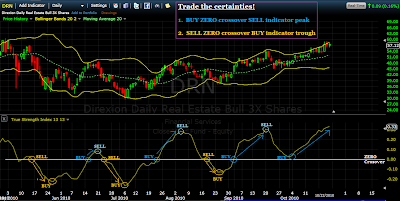*
It's been a while since I last put the basic trading tips and tricks of using the True Strength Index (TSI) indicator in a single post. So with the upcoming upleg in gold and miners just ahead, this should be a good time to review how the indicator works so that you, the reader, can join me in making profitable use of it.
*
I will offer three separate techniques for deriving BUY/SELL signals using the TSI indicator, but first let's begin with a basic understanding of how the indicator works.
*
This first chart attempts to illustrate the 4 conditions in which the TSI indicator is interpreted differently. The TSI line oscillates above and below a ZERO line yielding positive and negative readings over time. The 4 conditions are illustrated in different colors on this chart - 1 for each possible condition.
*
Those conditions are:
1. TSI rising above ZERO - 100% certainty price is rising
2. TSI falling below ZERO - 100% certainty price is falling
3. TSI falling *above* ZERO - price may be falling or consolidating sideways
4. TSI rising *below* ZERO - price may be rising or consolidating sideways
*
Trading Tip #1, of course, would be to trade the certainties.
*
That is, buy when the indicator crosses up though ZERO and hold as long as the indicator continues to rise above ZERO. AND, sell when the indicator falls down through ZERO and hold short as long as the indicator continues to fall below ZERO.
*
Honestly, you will find it difficult to find a more fool proof strategy than this one.
*
Trading Tip #2 is to trade the trend line breaks of the indicator.
*
All that is required to use this tip is the ability to draw straight lines and an eye for where to draw them. I practice drawing trend line breaks every day and you will find that it is pretty easy to get the hang of, especially with practice.
*
In fact, using FreeStockCharts to make these charts, I simply have trend lines drawn on the 150 mining stocks I follow and I wait, like a cat at the mouse hole, for the indicator to break a pre-drawn trend line. I pop through my 150 charts looking for a fish on the hook (broken trend line) and then pull the trigger - either to BUY or to SELL. Trust me, it works pretty well. :-)
*
Now if that is a tad too much work for you, Trading Tip #3 might be to your liking.
*
What you can do is simply add a fairly fast moving average, say (5), to the TSI indicator. When the indicator crosses up through the moving average, you BUY. When the indicator crosses down through the moving average, you SELL. Just make the color of the two lines different so you can visually keep them straight!
*
I don't personally use this moving average technique as I prefer to get a little faster signal from the trend line break trick, but if you are simply trying to trade longer swings and get most of the meat off the bone, with little effort, this is a great technique.
*
Now you may have noticed that in these examples I used a TSI setting of (13,13). This too, I do not use in real life. I always use (7,4). I used (13,13) in this post to make the lines smoother and the concepts easier to communicate and visualize.
*
My preference for the (7,4) setting is that it is faster to give me the signals and, with training I have learned how to mentally filter out a lot of the whipsaws that you will not see using (13,13).
*
I also always accompany the TSI (7,4) with a second indicator, Money Flow Index (10). I use basically the same techniques and tricks on the MFI indicator as the TSI indicator and it usually give me a validation of my TSI interpretation.
*
Hey, thanks for reading this far and I wish you very profitable trading using the True Strength Index (TSI) indicator. If I can further your understanding in any way, please do not hesitate to shoot me an email with your questions or thoughts. tsiTrader@gmail.com
Dec 31 premarket
1 day ago




![[Most Recent Quotes from www.kitco.com]](http://www.kitconet.com/images/quotes_special.gif)




Hi John, Do some stocks not show a tsi or am I doing something wrong? For example, SPR.V will only show the tsi when on the 5 yr monthly, anything shorter term I get no tsi line!? Thanks.
ReplyDeleteHi Jake -- I had no problem getting all the various time frames to load up SPR.V when I tried a couple minutes ago. Like they say, try, try, again - my best advice.
ReplyDeleteJohn, The tsi appears as you say but it's when you add the moving average line- tsi disappears and ma appears as flat horizontal line along the bottom!
ReplyDeleteJake -- I do not know how to respond. Are you asking a question, making a comment or ? Send me the chart if you would like me to look at it and understand - tsiTrader@gmail.com
ReplyDeleteHi John,I meant to ask why for some stocks (ex:CUI.V),the tsi appears on a 6 month chart but when I add a moving average (5) the tsi disappears and the ma line is a straight line along the bottom of the chart- I get this for some stocks but not for some others! Thanks for your time.
ReplyDeleteJake -- Now I understand what you are saying, I just do not see that on my chart - any time frame - of CUI.V. Not sure what to say, once again. I am sorry. But heck, what an incredible chart that CUI.v is! Looks like it will go right to 40 or 50. If you own it, let me know in a couple weeks how it turns out for you, OK?
ReplyDelete>On freechartstocks.com,the tsi appears but when you add a moving average the tsi disappears and the ma line is a straight line along the bottom of the chart-
ReplyDeleteThis drove me crazy but I found a fix:
Add Indicator TSI
When the Indicator appears at the bottom select the small arrow and select add indicator MVA from there.